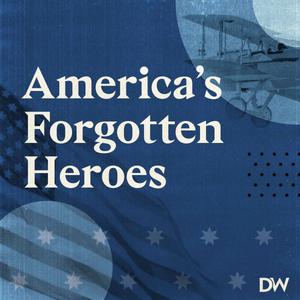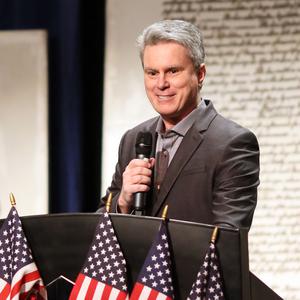
America's Forgotten Heroes
The Daily Wire
We are the children of heroes. These are the stories of seven men whose courage, determination and skill are so remarkable that it is nearly impossible to credit them as true. But the stories are true. These men were real. These things actually happened. Writer and series host Bill Whittle peels away the history, the colorless and drab recitation of dates and events, to reveal the actual human beings beneath the legend. Many of these men were national celebrities in their day, although a few of them never got the recognition that they deserved in their own time. The one thing that all seven have in common is the tragic fact that almost no one today can even recognize their names, let alone tell you anything about the actions that made those names worth remembering.
- 1 hour 13 minutesDick Rutan Breaks a Promise
By the mid 1980s, all of the aviation records that had so challenged the imaginations of pilots and the public alike had been achieved… except for one. Lindbergh had crossed the Atlantic. Aircraft had flown to both poles. Even the vast Pacific had been conquered. American jet bombers had flown around the world, but only after multiple refueling events. The only thing left to do that had not been done was to fly around the world, non-stop, on a single tank of gas. Dick Rutan had been a fighter pilot over Vietnam. He and his friend Mike Melville, who would go on to become the first private citizen in space, had flown around the world in the starkly original, otherworldly aircraft designed by his younger brother, Burt Rutan. Together with a relatively inexperienced pilot named Jenna Yeager, Dick Rutan started to plan for this impossible flight, assuming that his legendary younger brother could design a plane that could do it. The result was a bizarre, insect-like creation named Voyager; a flying fuel tank with about as much interior space as a telephone booth. At 8:01 am Pacific on the morning of December 14th, 1986, Dick Rutan and Jenna Yeager sealed themselves into Voyager and took off from Edwards Air Force base in California’s Mojave Desert and headed west. The plan was for each pilot to fly three hour legs, but it immediately became clear that Voyager was so fragile and unstable that Dick would do virtually all of the flying. The world had marveled at Charles Lindbergh for remaining awake for his 33 hour flight, but when Voyager, which had taken off into the west, arrived over Mojave coming in from the east, Dick Rutan had been flying for 216 hours pretty much non-stop. The last of the great aviation records had fallen due to the courage, endurance and persistence of Dick Rutan and the design genius of his brilliant younger brother, Burt.
Learn more about your ad choices. Visit podcastchoices.com/adchoices
7 July 2021, 10:00 am - 51 minutes 32 secondsFrank Luke Draws His Sidearm
Frank Luke was America’s second highest scoring ace in World War One. Over the course of twelve furious days, he shot down 17 enemy aircraft, many of them observation balloons, by far the most important, the most difficult and the most heavily defended targets of the war. He had been a fullback on his undefeated state champion high school football team in Phoenix, Arizona, before taking a job in the copper mines. An altercation with a professional fighter got him into the bare-knuckle boxing circuit, and when he tired of this he opened a dance hall and, wearing a dress, taught tough and lonely miners how to dance. He learned aerobatics while showing off over his fiancée’s house, and on his first combat training flight he thoroughly thrashed his veteran instructor. Desperate to fit in, he became known as a loud-mouthed braggart, and later a coward, but once he partnered with another outcast from his squadron he set a record string of amazing victories never equaled in that war. Those that saw him fly said he was the best pilot they had ever seen, one who would have easily defeated Manfred Von Richthofen, the infamous Red Baron. His actions on the ground after being shot down on his final mission made him the first aviator ever to win the Congressional Medal of Honor.
Learn more about your ad choices. Visit podcastchoices.com/adchoices
6 July 2021, 10:00 am - 1 hour 4 minutesErnest Evans Orders Left Full Rudder
As a young officer on an obsolete destroyer in the opening days of World War Two, Ernest Evans had watched a combined American, British and Australian fleet get decimated by the seemingly unstoppable Imperial Japanese Navy. Forced to cover the humiliating retreat, he swore if given a fighting ship of his own he would never run from enemy forces again. Made captain of a brand-new Navy destroyer, the USS Johnston, this full-blooded Cherokee drilled his crew endlessly, turning his command into a finely balanced, well-oiled fitting ship. On October 24th, 1944, Evans found himself confronted with a force of 19 Japanese battleships, heavy cruisers and destroyers. Without orders, he turned his unarmed Tin Can around and sailed directly at the Yamato, the most powerful warship ever created, any one turret of which weighed more than his entire ship. Following his example, the remainder of the unarmored destroyers and destroyer escorts guarding Task Force Three —callsign Taffy 3 — turned into utterly overwhelming odds, and fought so ferociously that the Japanese fleet abandoned their mission and turned around. For his actions that day in the Battle Off Samar Island, Ernest Evans was awarded the Congressional Medal of Honor and the story of Taffy 3 would enter the history books as the most amazing David vs. Goliath battles ever fought. and produce the most glorious two hours in the history of the United States Navy.
Learn more about your ad choices. Visit podcastchoices.com/adchoices
5 July 2021, 10:00 am - 56 minutes 45 secondsBooker T. Washington Catches the Late Train
Born into slavery on a Virginia plantation, Booker T. Washington’s relentless pursuit of an education would eventually bring him such renown that he would become the first Black American ever invited to a private dinner at the White House. Surrounded by bigotry, his advancement looked by what seemed overwhelming obstacles at every turn, his superhuman discipline, relentless persistence and willingness to work not only earned himself a first-rate education; his attitude had been so impressive, and his achievements so notable, that he was offered the position of Director of the Tuskegee Institute, the first source of higher education for blacks in the deep south. He arrived at Tuskegee to discover that there was no Tuskegee Institute: no buildings, no property and no staff. Through sheer force of character, he found a way to to raise a magnificent brick structure on the ground of a formerly abandoned plantation, and would start a partnership that would eventually be responsible for over five thousand individual school buildings for black students all across the South. His message of hard work, self-reliance, good will and personal discipline won him the respect, admiration and assistance of the same Southern Whites that had once owned him as property, and his example of self-respect and friendly cooperation is one we could use very much today.
Learn more about your ad choices. Visit podcastchoices.com/adchoices
4 July 2021, 10:00 am - 55 minutes 31 secondsJohn Paul Jones Sails Back from the War
John Paul was the son of a Scottish gardener, denied a career as an officer in the Royal Navy due to his humble origins. Falsely accused of murder —twice — he abandoned a career as a successful merchant captain and ran to Fredericksburg, Virginia where he added the most common name he could find in order to hide from the authorities. When the American Revolution began, this experienced seaman now known as John Paul Jones volunteered his services to the new republic. Using third rate ships and often mutinous crews, he took the American Revolution to the citizens of Great Britain, raiding coastal ports and causing panic throughout Great Britain. He fought, and won, two duels with the Royal Navy in their home waters, and in one of them, as his ship was sinking beneath him, his British opponent called across over the musket and cannon fire to inquire if he had surrendered. “I have not yet begun to fight!” he replied. Through matchless heroism, John Paul Jones, alone, made it clear to the British that the Americans could never be defeated because they were so much like themselves.
Learn more about your ad choices. Visit podcastchoices.com/adchoices
3 July 2021, 10:00 am - 1 hour 6 minutesJimmy Doolittle Releases the Brakes
On the morning of December 8th, 1941, the vaunted US Pacific fleet lay deep in the mud at the bottom of Pearl Harbor. Americans were stunned, but this was just the beginning, as the Japanese rampaged throughout the Pacific, seemingly unstoppable. The six aircraft carriers used on the attack at Pearl Harbor had been training for years, and their pilots were the best in the world flying bible Zero’s that flew circles around the lumbering US fighters, knocking them down in droves. America needed a victory — any victory, but ideally a bombing raid on the Japanese capital of Tokyo. But Tokyo was well out of range of Army Bombers, and the short range of Navy planes meant risking America’s few precious remaining aircraft carriers. But Franklin Roosevelt wanted to hit Japan, and so the project was handed over to the great celebrity aviator of the day, a 5’4” human dynamo named James Doolittle. Jimmy Doolittle had a history of effortlessly winning every air race he appeared in, and prior to the outbreak of the war he had been the first man to take off, fly, and land exclusive on instruments… instruments he had helped design. There was no better combination of brains, skill and courage in the world, and when he called for volunteers he was absolutely inundated, despite being able to tell the men anything about the mission other than that it would be exceedingly dangerous. After a great many modifications and a great deal of training, Doolittle did what everyone had assumed was impossible: he put huge Army bombers onto an aircraft carrier, and sailed them across the Pacific in the worst weather anyone had ever seen. The plan was to bomb Japan and then land in China, behind the Japanese troops that had been fighting and massacring the Chinese for four years before the attack on Pearl Harbor. When the raid was detected by Japanese ships they were still hundreds of miles short of their launch points, meaning that while they could still hit Japan, none of the aircraft would have the range to make it to safety. Doolittle’s crew of five Americans, and 15 other aircraft, lurched off the deck and staggerer into the air. The raid would prove so embarrassing to the Japanese Navy that they rushed into their crushing defeat at Midway, and the hardships endured by the volunteers on the Doolittle Raid beggars the imagination.
Learn more about your ad choices. Visit podcastchoices.com/adchoices
2 July 2021, 10:00 am - 53 minutes 42 secondsJoshua Lawrence Chamberlain Calls for the Bayonet
On July 3, 1863, Union forces easily took up a defensive line along a small rise call Cemetery Ridge in the peaceful Pennsylvania crossroad village called Gettysburg. But the extreme far left of the Union line was, in the parlance of the time, “in the air” — meaning it was not anchored to a river or forest or other natural barrier. Defense of the extreme let of the Federal line fell to the 20th Maine Infantry regiment, commanded by a Professor of Rhetoric named Joshua Lawrence Chamberlain. Standing on the crest of a small hill known as Little Round Top, Chamberlain immediately realized that to lose this position would mean that Confederate Artillery would be able to enfilade the entire Union line. The loss of Little Round Top meant the loss of the Battle of Gettysburg, and the loss of Gettysburg would mean the loss of the Pennsylvania capitol at Harrisburg. After the endless series of catastrophes suffered by the Army of the Potomac, the loss of a northern state capital might have been enough to bring Great Britain into war on the side of the Confederacy. Astonishingly, Chamberlain saw all of this very plainly. Robert E. Lee wanted Little Round Top, and launched wave after wave of attacks up the thickly forested hill. By the time of the penultimate charge, Chamberlains men were out of ammunition and reduced to throwing rocks. As his exhausted, bloodied and battered men faced yet another Confederate charge, Chamberlain, acting on instinct, personally led Union bayonets in a counter-charge that saved the position, the battle, and possibly the war.
Learn more about your ad choices. Visit podcastchoices.com/adchoices
1 July 2021, 10:00 am - 1 minute 10 secondsAmerica's Forgotten Heroes Launch Trailer
We are the children of heroes.
These are the stories of seven men whose courage, determination skill are so remarkable that it is nearly impossible to credit them as true. But the stories are true. These men were real. These things actually happened.
Writer and series host Bill Whittle peels away the history, the colorless and drab recitation of dates and events, to reveal the actual human beings beneath the legend. Many of these men were national celebrities in their day, although a few of them never got the recognition that they deserved, in their own time. The one thing that all seven have in common is the tragic fact that almost no one today can even recognize their names, let alone tell you anything about the actions that made those names worth remembering.
Learn more about your ad choices. Visit podcastchoices.com/adchoices
27 October 2020, 6:01 pm - More Episodes? Get the App
Your feedback is valuable to us. Should you encounter any bugs, glitches, lack of functionality or other problems, please email us on [email protected] or join Moon.FM Telegram Group where you can talk directly to the dev team who are happy to answer any queries.
 The Andrew Klavan Show
The Andrew Klavan Show
 The Ben Shapiro Show
The Ben Shapiro Show
 Bill Whittle Network
Bill Whittle Network
 The Matt Walsh Show
The Matt Walsh Show
 The Cold War: Prelude To The Present
The Cold War: Prelude To The Present
 Morning Wire
Morning Wire